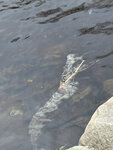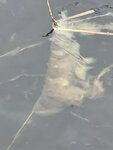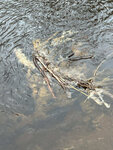BRASHER -- A meeting with DEC officials will be held at the Tri-Town Arena pavilion at 6 p.m. tonight, giving residents an opportunity to address concerns about pollution in the Deer River.
…
This item is available in full to subscribers.
To continue reading, you will need to either log in to your subscriber account, or purchase a new subscription.
If you are a digital subscriber with an active, online-only subscription then you already have an account here. Just reset your password if you've not yet logged in to your account on this new site.
Otherwise, click here to view your options for subscribing.
Please log in to continue |



BRASHER -- A meeting with DEC officials will be held at the Tri-Town Arena pavilion at 6 p.m. tonight, giving residents an opportunity to address concerns about pollution in the Deer River.
According to organizers, the meeting was requested weeks ago and DEC officials agreed to hold a public meeting with residents to better address the situation.
The meeting comes months after initial reports of white globules in the Deer River that many had suspected was whey byproduct from North Country Dairy, a dairy processing plant on the river.
On multiple occasions, residents have attended town board meetings and a full board meeting of the county legislature to raise concerns and ask for help.
James Gurrola, a North Lawrence resident who owns property on the river, spoke to NCTW about the contamination in June, describing the stench as "if you were opening a jar of rotting chicken that's been fermenting with maggots."
That description, along with photos and water samples was enough to spur county officials into action with Legislator John Gennett taking the lead.
Gennett previously told NCTW that the situation needed to be rectified immediately to avoid what would be a "multi-generational disaster."
"We've seen this before in the North Country and if it is not handled now, if the DEC doesn't put a stop to this, it will take generations for this river to be cleaned up and for wildlife to come back," he said.
Fishing promoter Don Meissner echoed the sentiment during a Massena town board meeting recently, saying the situation needs to be taken seriously before it gets any worse.
He told town board members the Deer River has been home to some of the best fishing in the area, but the contamination appears to be causing widespread damage to the habitat. As a result, fish cannot be found for several miles in the river, he said.
Following months of public outcry DEC officials announced an investigation was underway, with samples of the material having determined the growth to be primarily Leptomitus lacteus, “a filamentous microorganism similar to a fungus.”
That news broke June 18 but DEC officials said the source of the contamination was still unknown at the time.
“Dense growth like what was found in the river is typically an indicator of high nutrients and organic material in the water. Additional factors such as changes in temperature and other water quality parameters may also affect its growth,” DEC officials said.
Weeks later, North Country Dairy issued their first public statement on the situation, saying they were in close communication with the DEC and local council members as they sought to determine the root cause of the contamination.
"We join in that concern, as the health of our shared environment is incredibly important to us—not just as a company, but as individuals who live and work here, raise our families here, and care deeply about this community," North Country Dairy officials said in the June 30 release.
They went on further, saying they were in close communication with community members, local council members and the DEC about the issue.
"As a highly regulated facility, we strive to operate our plant in a way that not only complies with recommended practices but exceeds them. We are collaborating with the DEC in its ongoing investigation while continuing an internal review of our operations to ensure they meet our high expectations and all applicable regulatory requirements," officials said.
But just two days later the DEC cited the dairy plant for contributing to the contamination of the river.
According to DEC officials, a detailed technical review of the plant's wastewater and treatment technologies were also completed to ensure pending modifications to the facility's permit will protect the Deer River.
“Immediately following the outbreak of Leptomitus lacteus in the Deer River, DEC experts launched an investigation to identify its underlying causes, resulting in the enforcement action announced today,” Region 6 Director Randall Young said.
“Our team will continue to take appropriate action to restore and protect the river and the surrounding community.”
Gennett expressed support for the investigation but pressed further, saying the DEC needed to rectify the situation immediately.
"The residents of Lawrence and Brasher have demanded answers about why their once-clear river has become unsafe for traditional uses. While I commend the New York State Department of Environmental Conservation (DEC) for their efforts to identify and address the issue, the delays have been frustrating. I remain committed to advocating for my constituents and working with the DEC and local leaders to swiftly restore the Deer River to its former pristine state," said Gennett.
No punitive measures were announced in the July 2 release, however a DEC official told NCTW "The DEC will issue a Notice of Violation (NOV) to notify an entity of alleged violations, seek a response, and to prompt corrective actions. After the issuance of any NOV, there is the potential for future enforcement action, which may result in penalties. DEC does not comment on the specifics of pending enforcement matters."
No punitive measures have been announced yet, however organizers have said they expect the plant to assist with remediation efforts in the river.